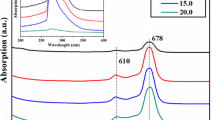Abstract
Based on the J-aggregation mechanism of α-aryl/alkoxy-substituted zinc phthalocyanines(Pcs) in non-coordinating solvents, two novel azobenzene-phthalocyanine dyads (3-azo-ZnPc and 4-azo-ZnPc) were synthesized with the aim of developing Pc compounds whose ability to form J-aggregation could be photo-modulated. It was found that 3-azo-ZnPc in chloroform could be effectively photo-controlled in a wide range. This phenomenon could be explained by the changes in the geometry and dipole moment of azobenzene during the photo-isomerization process. 4-azo-ZnPc did not have this ability at all, with or without UV light illumination. The positions of the oxygen atoms to which the aryl/alkoxy substitution was attached relatively were found important in determining the aggregation ability.
Similar content being viewed by others
References
Hiroaki I. Spectral properties of a novel antimony(III)-phthalocyanine complex that behaves like J-aggregates in non-aqueous media. Chem Commun, 2003. 1864–1865
Zhang T L, Yan J M, Liu Y Q, et al. Electron structures and non-linear optical properties of tertbutyl-nitro-phthalocyanines. Chin Sci Bull, 1999, 44: 694–698
Kobayashi L. Cation or solvent-induced supermolecular phthalocyanine formation: crown ether substituted phthalocyanines. J Am Chem Soc, 1987, 109: 7433–7441
Furuki M, Wada O, Pu L S, et al. Fabrication and femtosecond optical response of Langmuir-Blodgett films with two-dimensional J-aggregates. J Phys Chem B, 1999, 103: 7607–7612
Adachi K, Watarai H. Interfacial aggregation of thioether-substituted phthalocyaninatomagnesium (II).palladium(II) complexes in the toluene/water system. J Mater Chem, 2005, 15: 4701–4710
Kameyama K, Morisue M, Satake A, et al. Highly fluorescent self-coordinated phthalocyanine dimmers. Angew Chem Int Ed, 2005, 44: 4763–4766
Huang X, Zhao F, Li Z, et al. Self-assembled nanowire networks of aryloxy zinc phthalocyanines based on Zn-O coordination. Langmuir, 2007, 23: 5167
Huang X, Zhao F, Li Z, et al. A novel self-aggregates of phthalocyanine based on Zn.O coordination. Chem Lett, 2007, 306: 108
Shiratori K, Nagamura T. Study on photochromism of amphiphilic spiropyran monolayers by surface reflection. J Photopoly Sci Technol, 2001, 14: 233–238
Tachibana H, Yamanaka Y, Sakai H, et al. J-aggregate formation in single-layer amphiphilic spiropyran Langmuir-Blodgett films. Chem Lett, 2000, 1182–1183
Tachibana H, Yamanaka Y, Matsumoto M. Surface and photochemical properties of Langmuir monolayer and Langmuir-Blodgett films of a spiropyran derivative. J Mater Chem, 2002, 12: 938–942
Matsumoto M, Terrettaz S, Tachibana H. Photo-induced structural changes of azobenzene Langmuir-Blodgett films. Adv Colloid Interface Sci, 2000, 87: 147–164
Terrettaz S, Tachibana H, Matsumoto M. Investigation of photosensitive Langmuir-Blodgett monolayers by in situ atomic force microscopy and absorption spectroscopy. Langmuir., 1998, 14: 7511–7518
Li X Y, Sinks L E, Rybtchinski B, et al. Ultrafast aggregate-to-aggregate energy transfer within self-assembled light- harvesting columns of zinc phthalocyanine tetrakis (perylenediimide). J Am Chem Soc, 2004, 126: 10810–10811
A W. Snow in The Porphyrin Handbook, Vol. 17 (Eds Kadish, K M, Smith K M, Guilard R), Elsevier Science, USA, 2003. 129–176
Escosura A, Martinez-Diaz M V, Thordarson P, et al. Donor-acceptor phthalocyanine nanoaggregates. J A Chem Soc, 2003, 125: 12300–12308
Cook M J, Jafari-Fini A. Pyridino[3,4]tribenzoporphyrazines: edge-to-faceversus face-to-face assemblies among phthalocyanine analogues. J Mater Chem, 1997, 7: 2327–2329
Li X, Ng D K P. Self-assembly of meso-pyridylporphyrins and zinc phthalocyanines through axial coordination. Eur J Inorg Chem, 2000, 1845–1848
Kobayashi N, Muranaka A, Nemykin V N. The first phthalocyanine-based dimer formed by two pyridine-Pd-pyridine bridges. Tetrahedron Lett, 2001, 42: 913–915
Ishii K, Watanabe Y, Abiko S, Kobayashi N. A novel phthalocyanine-based dimer linked by a silver Ion: structural control of self-assembled dimmers. Chem Lett, 2002. 450–451
Yagai S, Kitamura A. Photocontrollable self-assembly. Chem Eur J, 2005, 11: 4054–4063
Sudesh K G, Neckers D C. Photochemistry of azobenzene-containing polymers. Chem Rev, 1989, 89: 1915–1925
Chen Z, Zhong C, Zhang Z, et al. Photo-responsive J-aggregation behavior of a novel azobenzene-phthalocyanine dyad and its third-order optical nonlinearity. J Phys Chem B (accepted)
Gouterman, M. The Porphyrins (In: Dolphin, D ed), Vol. III, Acdamic Press, NY 1978. 1–165
Author information
Authors and Affiliations
Corresponding author
Additional information
Supported by the National Natural Science Foundation of China (Grant Nos. 20572059, 20502013 and 20773077), National Key Fundamental Research Program (Grant No. 2007CB808000)
About this article
Cite this article
Niu, L., Zhong, C., Chen, Z. et al. Novel azobenzene-phthalocyanine dyads—design of photo-modulated J-aggregation. Chin. Sci. Bull. 54, 1169–1175 (2009). https://doi.org/10.1007/s11434-009-0099-1
Received:
Accepted:
Published:
Issue Date:
DOI: https://doi.org/10.1007/s11434-009-0099-1




